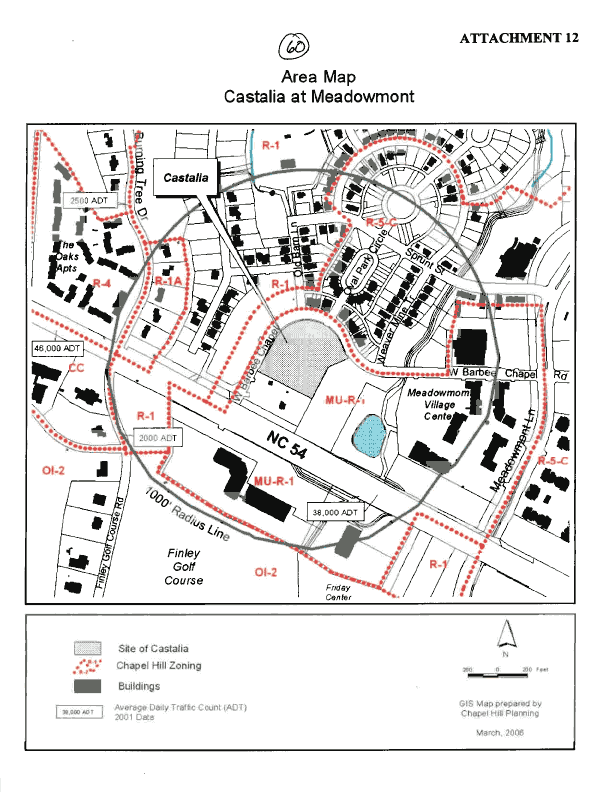The following is from my first column for the Chapel Hill News. In a strange inversion of most ‘bloggers trajectories, I’m moving, slightly, from electronic to paper media.
First, a quick correction. In trying to trim my column to 750 words I made a mistake joining two sentences concerning the citizen’s financial outlays to-date. The Mayor says we’ve spent about $600K on the project plans. Matt Dee’s, in a Feb. 28th, 2006 News & Observer article, said:
Town leaders have spent about four years and more than $1 million taking plans from vague brainstorms to the detailed drawings shown Monday night.
I bet if you added in all the staff, Council and consultancy time, the real expenditures over the last 4-5 years, the figure would be above $1 million. If you pull in the legal and staff costs associated with the first run at leveraging the Wallace deck for downtown redevelopment, the Rosemary Square project, I’m sure the figure would go much higher.
In any case, it is not $4 million.
What are the true expenditures to-date? I will be doing some additional research to find out.
What about potential cost to the citizen? If we use the Mayor’s figures, we’ve spent $600K to-date, have a commitment to spend $500K more digging a futile hole in lot #5 and will be “kicking back” the $7.9 million earned on the 99 year lease agreement with RAM development. And, already, the $500K for the “hole” is in dispute.
With that in mind, here’s my column:
Over the nearly six years I’ve worked downtown, I’ve watched the nearby parking lot’s tree-lined sidewalks magnificently bloom in spring, shade our citizens in summer and explode with dazzling reds and yellows each fall. One of the few remaining unencumbered downtown public parcels, this human-scale open area visually connects and integrates Franklin Street into the surrounding neighborhoods.
A few months ago, two stately trees across the street were cut down, replaced by the mammoth metal posts of our town’s fancy new-style traffic signals. “How many folks thought about those trees?” I wondered. “Will anyone else miss them? How long will they furnish my memories?”
In 1979, the noxious gridlock of N.C. 54 years away, my first pleasant drive from Raleigh to town’s edge was interrupted only by the route’s sole traffic signal. Through rolling verdant pastures, past the quaint University Inn.
A right at the quiet Old Chapel Hill Cemetery. Under the arched trees of Raleigh Street. A left turn onto historic Franklin Street. An easy park at UNC’s publicly accessible lot in Porthole Alley.
Downtown, though replete with historic ambiance, exuded a youthful confidence. Locally owned record, grocery, hardware, clothes and stereo stores competed for my hard-earned lucre. Three cheap movie theaters within two blocks provided a welcome retreat into air-conditioned bliss. Restaurants ran the gamut of tastes and expense.
Enamored, I regularly spent a few bucks on the six-hour jaunt to Chapel Hill. Smelling of diesel fumes, I’d arrive at the bus terminal thirsty and travel wearied. Exiting onto the delightfully shaded lawn, I’d hop across the street to retrieve an ice-cold brew from Fowler’s Big Bertha (that grocery’s storied walk-in freezer).
I fondly remember that downtown.
Over the ensuing decades the evolving character of our “village on the rise” shifted. Fowler’s grocery closed with no replacement. Huggin’s Hardware, hammered by the pricing pressure of Lowe’s, became a casualty of our town’s first experiment with “big box” retailers. Competing against university and national chains, the Intimate Bookshop burned financially. Both Laundromats washed out. The Carolina Blue & White closed, then opened, now darkened again.
Meadowmont’s broken promise despoiled those welcoming pastures. The Wallace Deck vanquished the starry skies above my friends’ North Street back yard. UNC’s parking policies hampered free access. The Cobb chiller plant disturbed the quiet of the grave. A luxury hotel erased the terminal’s pleasant lawn.
During the same era, well-intentioned leadership, bolstered by developers’ promises, worked to constrain sprawl within our rural buffer, approved developments ringing town and created today’s donut-like topology that draws economic activity to the periphery.
Speculating that increased residency will revive downtown’s economic fortunes, the Town Council entered a private-public partnership with RAM Development to convert citizen-owned properties into mixed-use residential-commercial developments with 230 housing units.
Investing $4 million to date in the effort, the project is nearing the public hearing phase. Clear cut and excavated, my beautiful public space will vanish under the private heel of a looming “soft modernistic” behemoth. Rising nine stories, this disproportionate edifice will distort Franklin Street’s current village-like scale.
Where is the public utility, the community orientation? Why a hard concrete concourse, a “hands-off” fountain in lieu of a grassy sward and a kid-friendly splash park? Where’s the commitment to decent public bathrooms and drinking fountains? Why boutique shops instead of a natural community magnet like a grocery store? With competing private projects proposing hundreds of additional downtown dwellings and current cost projections more than $100 million, why develop the tracts at all?
Over the last 18 months, my disappointment increased, my support eroded. I began to wonder if town was following the failed trajectory of 1984’s $30 million Rosemary Square project as a council once again attempted to reform downtown.
The fires of my opposition ignited the night council discussed the project’s window treatments with more passion than the escalating public cost. Increased outlays to our consultant added tinder. When RAM Development disclosed plans to build 335 luxury condos near downtown, the largest such project in town’s history, and the mayor shrugged off the potential conflict of interest adjudging their development partner’s plans, the flickers swelled.
Finally, with the recent call for citizens to shoulder the developer’s private debt via tax incremental funding (TIFs), those nascent flickers firmed into the flame of resistance.
Council member Cam Hill, a key member of the negotiating team, recently said, “I do know I’m not afraid to walk away from it. I’m not wed to building something on lot 5 to the point of making a deal I don’t like.”
Cam, it’s time to dig out your running shoes and run, don’t walk, to the nearest exit.

